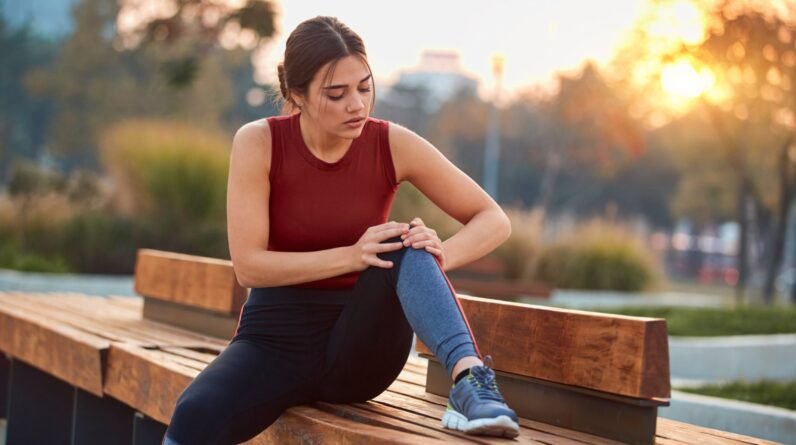
Whether you’ve experienced a twinge in your hip while picking up your toddler or had to skip the half marathon you’ve been training for because of dull ache—or both—hip pain can be a nagging, and at times debilitating, condition that can cause you to put life on pause.
Though dealing with an injury can sometimes feel super isolating (IYKYK), hip pain is one of the most common injuries out there. Fortunately, there are several ways to assess and treat hip pain, depending on what’s behind the issue.
Ahead, check out expert advice on how to figure out what sort of hip pain you’re dealing with, how to treat it, exercises and stretches that might help, and signs it’s time to check in with a professional.
Experts In This Article
- Christopher Churchill, PT, DPT, OCS, CSCS, advanced clinician at the Hospital of Special Surgery
- Cynthia Sampson, PT, DPT, CPT, physical therapist at Bespoke Treatments in NYC
- Jon Mayer, PT, DPT, CSCS, physical therapist at the Medical University of South Carolina
4 causes of hip pain
One of the first key steps to eliminating hip pain is to figure out what kind of pain you’re experiencing. Good news: There’s a lot of possibilities. Bad news: There’s a lot of possibilities. But one quick distinction, which will likely need to come from a licensed medical provider, can help point you to remedy the issue.
Potential causes of hip pain frequently fall into two overarching categories: intra-articular pain—which deals with the hip joint (the joint capsule and labrum), like osteoarthritis—and extra-articular pain, which addresses problems with the muscle, tendons, and bursa that surround the hip joint, explains Jon Mayer, PT, DPT, CSCS, physical therapist at the Medical University of South Carolina.
1. Hip osteoarthritis
If your hip has started to feel creaky when you wake up, you might want to ask your doctor about this condition. “Osteoarthritis is a degenerative joint disease that leads to pain, stiffness, and inflammation in the hip. Typically, patients will experience pain in the groin, side of the hip or buttock. They can feel stiffness in the hip especially in the morning or after being seated for a long period of time,” says physical therapist Christopher Churchill, PT, DPT, OCS, CSCS, advanced Clinician at the Hospital for Special Surgery.
This condition becomes more prevalent in folks over the age of 50 or those who have a family history of hip osteoarthritis, Churchill says. If you’ve started to experience popping or grinding in your hip or have started to have difficulty completing daily activities like tying your shoes, several of the common symptoms per Churchill, you might want to connect with your doctor.
2. Overuse injuries
Overuse injuries are a pain, in this case, literally, in an athlete’s side. “Hip pain can stem from various causes, including common overuse injuries such as gluteal tendinitis, iliopsoas tendinitis, and bursitis. These conditions are often aggravated by repetitive activity and overload,” says Cynthia Sampson, PT DPT, a physical therapist at Bespoke Physical Therapy.
According to Churchill, overuse injuries like tendonitis and bursitis can “occur when the soft tissue structures around the hip such as tendons and bursa become inflamed due to overload from activities.” If you’re navigating gluteal tendinopathy, one of the most common hip overuse injuries, you might frequently experience pain “at the side of the hip and you may feel tender in this area,” he adds. Echoing Sampson, Churchill says you might feel pain walking or running, or after sitting for long periods and lying on the symptomatic side.
3. Hip impingement or femoroacetabular impingement (FAI)
Yet another overuse injury, hip impingements can occur when there’s “abnormal contact between the femoral head (ball of thigh bone) and acetabulum (socket of pelvis) that can eventually cause pain in the front of the hip and/or groin,” Mayer says.
Common symptoms include “sharp groin pain and clicking, locking, or catching sensation, according to Mayer. If you’re dealing with this, your deep squats might be more difficult or painful, he said. Mayer says that, as with other overuse injuries, folks who perform the same repetitive movement are most vulnerable to this injury, especially “active young adults and athletes in sports with repetitive rotational hip movements like soccer, hockey, or dance.”
4. Labral tear
A hip impingement can evolve into a labral tear, per Churchill. Femoroacetabular Impingement (FAI) is a condition that can lead to friction within the hip joint, he says. “This friction can lead to a labral tear, which is the damaging of the cartilage that lines the hip joint. FAI and labral tears are conditions that can commonly be seen in conjunction, but not always,” he says.
As with the hip impingement, you may struggle with squatting or twisting, Churchill says. You may also experience pain in your groin or front of the hip. Athletes like hockey players, golfers, and dancers might be most at risk as their activities require repetitive motion that can exacerbate the injury.
How to relieve hip pain
To start addressing hip pain, it’s best to reduce—or fully stop, if possible—the movement that’s causing the discomfort. “The first step in relieving hip pain is rest and activity modification. Aggravating activities should be avoided in the short term to avoid further irritation of the hip,” said Churchill.
From there, it’s best to work with a licensed physical therapist to help address what’s going on—and determine the appropriate exercises and stretches. “A skilled physical therapist can identify the underlying causes of pain by assessing factors such as range of motion, strength, load management, and overall joint function,” Mayer says. “They can also pinpoint specific activities or movement patterns that should be temporarily modified or avoided altogether to allow symptoms to calm down before beginning the process of rebuilding any impairments of strength, stability and mobility to improve tolerance to physical activity.”
Once you are ready to begin rebuilding strength, it’s key to have a professionally tailored game plan to help you recover safely and effectively. For example, “hip pain caused by tendinitis, bursitis, and hip impingement would all benefit from strengthening the glutes, hip flexors, hip abductors, hip adductors, and deep hip rotators,” Sampson says. However, if you’re dealing with osteoarthritis, you might require any entirely different plan.
5 stretches and exercises to address hip pain
If you’re hoping to ease hip pain or strengthen your hip muscles to help avoid pain in the first place, the experts provided several moves to try.
“It’s important to note that exercise is never one size fits all and should be tailored to your individual situation and goals. While exercise programs may begin with lower intensity options at first, it’s important that they eventually progress to more challenging options,” Mayer says.
Of course, if you feel anything resembling pain while doing any of these moves, stop doing it, and check in with your physical therapist to make sure you have the technique down—and there aren’t any injuries to flag.
1. Seated glutes stretch (each side separately)
- Start seated with a straight back and both feet flat on the floor.
- Cross your left ankle over your right knee.
- Press your left knee down as far as it can comfortably go and begin to bend forward at the hips without arching your back.
- Move your torso back and forth for a dynamic stretch.
- Do 3 sets of 30-second holds
2. Side-lying hip abduction against wall (each side separately)
- Lie on your left side against a wall with your bottom leg bent and your top leg extended straight. Prop up your torso on your left elbow, and place the right hand on the floor in front of your ribs for balance.
- Engage your core so that the left side of your torso is taut, not collapsing into the floor. Lift the right leg up to about shoulder height, engaging the outer thigh and hip muscles. Keep the knee pointed forward, and don’t allow your hips to tip or move.
- Lower the right leg with control. That’s 1 rep.
- Do 3 sets of 10 reps per side.
To make sliding your foot on the wall easier, place a hand towel or washcloth underneath your top heel, as shown in the video above.
3. Standing hip controlled articular rotation (CAR) (each side separately)
- Stand on your right leg and lift your left knee toward your chest to hip height.
- Rotate your left leg out to the side, then behind you, then back to the starting position.
- Place your left foot on the floor.
- Do 1 set of 5 reps per leg in each direction (clockwise, then counterclockwise).
Avoid arching your lower back and hold onto a chair if balance is an issue.
4. Half-kneeling hip flexor stretch (each side separately)
- Start in a half-kneeling position with your left foot out in front.
- Place your hands on your hips.
- Lean forward slightly so you feel a stretch in your left quadriceps and hip flexors.
- Do 3 sets of 30-second holds.
5. Banded glutes bridge
- Loop a mini band right above your knees.
- Lie faceup with your arms by your sides, knees bent and feet flat on the floor hip-width apart. Your feet should be close enough to your hips that if you reach one hand at a time toward each heel, you could just touch it with your fingers.
- Tuck your tailbone slightly. Squeeze your glutes and core, then press your feet into the floor to drive your hips up toward the ceiling, coming into a glutes bridge.
- Hold for 3-5 seconds, then lower your hips back down to the floor.
- Do 3 sets of 10 reps.
When it’s time to see a doctor
So, you’ve noticed a new ache after upping your load at the squat rack. Or maybe you’ve been having more difficulty moving around, climbing stairs, or racing after your children. These are all signs it’s time to check in with a doctor, the experts agree.
There are a few important symptoms not to ignore: “Numbness or tingling radiating down the leg, feelings of instability, or locking or catching within the hip,” Churchill says.
Oh, and do yourself a favor and lay off social media for any sort of personalized guidance. “I see many patients who have attempted to treat themselves via exercises they’ve seen on social media and have ended up only worsening their symptoms,” Mayer says. “It’s important to be assessed by an expert to identify contributing factors to your specific pain and to create an individualized treatment plan that will allow you to get back to the activities you love with full confidence.”







